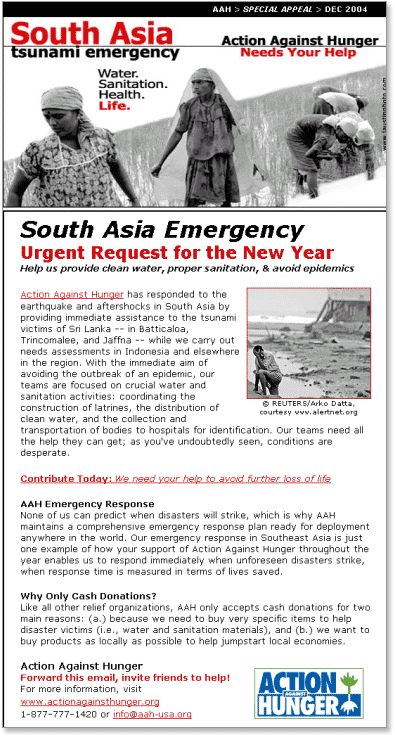|
Driving Online Support for Tsunami Victims, Plus a New Pool of Supporters for the Future: Action Against Hunger For many nonprofit organizations, the Internet is playing a key role in the relief effort for people affected by the December 26, 2004 tsunami in Southeast Asia. Just as former Vermont Gov. Howard Dean's 2004 presidential campaign inspired record numbers of donors to contribute online by reaching out to them with quick email and Web site communications, nonprofit organizations are using online tools to get the word out about their tsunami aid campaigns. In response, they are seeing not only unprecedented giving as people pull out their credit cards to donate online, but also a wave of new constituents to support their organization in the future. Action Against Hunger (AAH) has seen the benefits of using the Internet for its tsunami relief campaign. Recognized worldwide as a leader in the fight against hunger, AAH delivers programs in more than 40 countries, specializing in emergency situations of war, conflict and natural disasters, and longer-term assistance to people in distress. With an annual budget of about $10 million, the organization’s goal is to help vulnerable populations regain their self-sufficiency for long-term sustainability. In the days following the tsunami, AAH sprung into action, using Convio online software to send emails to its house file, promote its tsunami aid fundraising efforts and take donations online. Between December 26, 2004 and January 5, 2005, AAH raised about $408,000 online earmarked for tsunami relief efforts. “Using our Convio email and Web tools, we were able to raise more than $400,000 in funds desperately needed to help the tsunami victims,” Anne Sophie Fournier, Executive Director at Action Against Hunger, said. “Without the ability to immediately send emails, post our tsunami donation page online and process credit card donations automatically, we could not have raised so much, so quickly, to help this relief effort.” To put AAH’s post-tsunami fundraising results in perspective, consider that the organization raised 65 percent of all of its online funds in 2004 during the last week of the year — the week following the tsunami. Online donations for the week prior to the tsunami were $3,137. Because the donations were made online using credit cards, AAH had immediate access to the funds for tsunami relief programs.
These new constituents — who may have made a donation, signed up for a newsletter or registered to receive email updates — provided the organization their email addresses, giving AAH a new pool of individuals to target for future marketing and fundraising efforts. This is particularly significant because prior to its tsunami relief campaign, AAH was largely grant-funded. "Ninety-nine percent of all nonprofits involved in public safety and disaster preparedness/relief are small-to-medium size organizations with annual operating budgets of $10 million and less,” Gene Austin, CEO, Convio, said. “In the short term, these nonprofits, including Action Against Hunger, are using the Internet strategically and mobilizing record numbers of constituents — many of whom are new — to donate and provide other forms of mission-critical support. Longer term, these smaller groups will be able to have an impact as significant as the larger, better branded organizations."
Have a colleague who might be interested in this topic? Why not forward this article?
|
|




